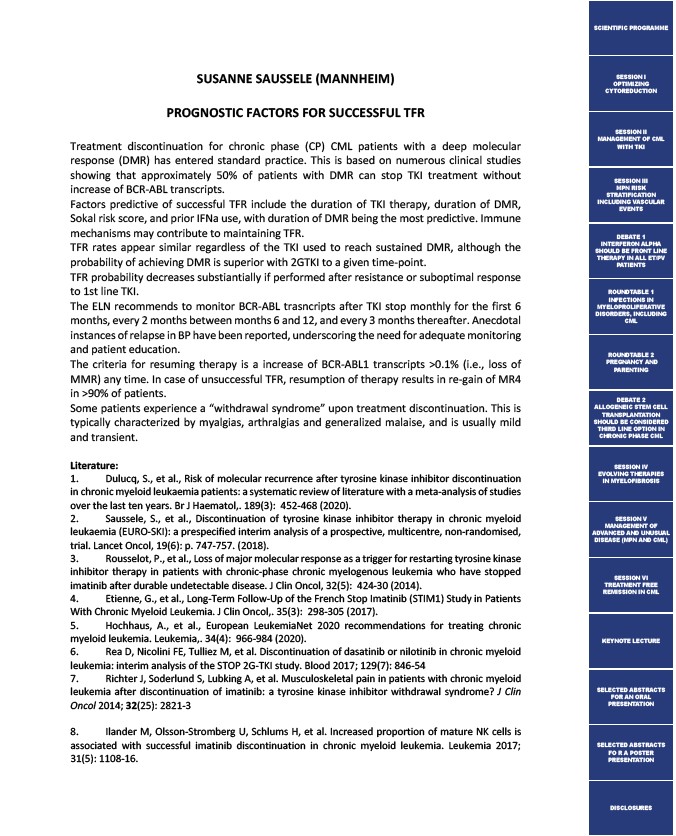
SUSANNE SAUSSELE (MANNHEIM)
PROGNOSTIC FACTORS FOR SUCCESSFUL TFR
Treatment discontinuation for chronic phase (CP) CML patients with a deep molecular
response (DMR) has entered standard practice. This is based on numerous clinical studies
showing that approximately 50% of patients with DMR can stop TKI treatment without
increase of BCR-ABL transcripts.
Factors predictive of successful TFR include the duration of TKI therapy, duration of DMR,
Sokal risk score, and prior IFNa use, with duration of DMR being the most predictive. Immune
mechanisms may contribute to maintaining TFR.
TFR rates appear similar regardless of the TKI used to reach sustained DMR, although the
probability of achieving DMR is superior with 2GTKI to a given time-point.
TFR probability decreases substiantially if performed after resistance or suboptimal response
to 1st line TKI.
The ELN recommends to monitor BCR-ABL trasncripts after TKI stop monthly for the first 6
months, every 2 months between months 6 and 12, and every 3 months thereafter. Anecdotal
instances of relapse in BP have been reported, underscoring the need for adequate monitoring
and patient education.
The criteria for resuming therapy is a increase of BCR-ABL1 transcripts >0.1% (i.e., loss of
MMR) any time. In case of unsuccessful TFR, resumption of therapy results in re-gain of MR4
in >90% of patients.
Some patients experience a “withdrawal syndrome” upon treatment discontinuation. This is
typically characterized by myalgias, arthralgias and generalized malaise, and is usually mild
and transient.
Literature:
1. Dulucq, S., et al., Risk of molecular recurrence after tyrosine kinase inhibitor discontinuation
in chronic myeloid leukaemia patients: a systematic review of literature with a meta-analysis of studies
over the last ten years. Br J Haematol,. 189(3): 452-468 (2020).
2. Saussele, S., et al., Discontinuation of tyrosine kinase inhibitor therapy in chronic myeloid
leukaemia (EURO-SKI): a prespecified interim analysis of a prospective, multicentre, non-randomised,
trial. Lancet Oncol, 19(6): p. 747-757. (2018).
3. Rousselot, P., et al., Loss of major molecular response as a trigger for restarting tyrosine kinase
inhibitor therapy in patients with chronic-phase chronic myelogenous leukemia who have stopped
imatinib after durable undetectable disease. J Clin Oncol, 32(5): 424-30 (2014).
4. Etienne, G., et al., Long-Term Follow-Up of the French Stop Imatinib (STIM1) Study in Patients
With Chronic Myeloid Leukemia. J Clin Oncol,. 35(3): 298-305 (2017).
5. Hochhaus, A., et al., European LeukemiaNet 2020 recommendations for treating chronic
myeloid leukemia. Leukemia,. 34(4): 966-984 (2020).
6. Rea D, Nicolini FE, Tulliez M, et al. Discontinuation of dasatinib or nilotinib in chronic myeloid
leukemia: interim analysis of the STOP 2G-TKI study. Blood 2017; 129(7): 846-54
7. Richter J, Soderlund S, Lubking A, et al. Musculoskeletal pain in patients with chronic myeloid
leukemia after discontinuation of imatinib: a tyrosine kinase inhibitor withdrawal syndrome? J Clin
Oncol 2014; 32(25): 2821-3
8. Ilander M, Olsson-Stromberg U, Schlums H, et al. Increased proportion of mature NK cells is
associated with successful imatinib discontinuation in chronic myeloid leukemia. Leukemia 2017;
31(5): 1108-16.
SCIENTIFIC PROGRAMME
SESSION I
OPTIMIZING
CYTOREDUCTION
SESSION II
MANAGEMENT OF CML
WITH TKI
SESSION III
MPN RISK
STRATIFICATION
INCLUDING VASCULAR
EVENTS
DEBATE 1
INTERFERON ALPHA
SHOULD BE FRONT LINE
THERAPY IN ALL ET/PV
PATIENTS
ROUNDTABLE 1
INFECTIONS IN
MYELOPROLIFERATIVE
DISORDERS, INCLUDING
CML
ROUNDTABLE 2
PREGNANCY AND
PARENTING
DEBATE 2
ALLOGENEIC STEM CELL
TRANSPLANTATION
SHOULD BE CONSIDERED
THIRD LINE OPTION IN
CHRONIC PHASE CML
SESSION IV
EVOLVING THERAPIES
IN MYELOFIBROSIS
SESSION V
MANAGEMENT OF
ADVANCED AND UNUSUAL
DISEASE (MPN AND CML)
SESSION VI
TREATMENT FREE
REMISSION IN CML
KEYNOTE LECTURE
SELECTED ABSTRACTS
FOR AN ORAL
PRESENTATION
SELECTED ABSTRACTS
FO R A POSTER
PRESENTATION
DISCLOSURES